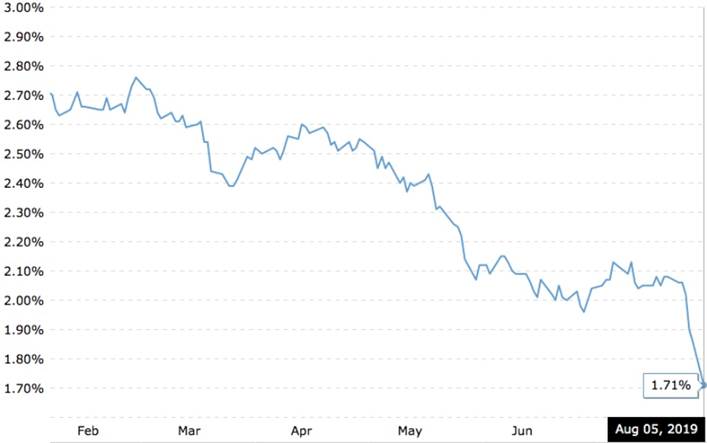Trump’s perfect gold storm

2019.08.07
Gold prices continued to march upward on Wednesday, trading at $US1,501.20 on Wednesday as of this writing.
Gold has been on a tear the past month, the beneficiary of an increasingly dovish monetary environment, as central banks around the world cut interest rates and roll out bond-buying programs to stimulate sagging economic growth.
Despite not bearing a yield, gold tends to do well under low interest rates because it holds its value against fiat currencies which rise and fall with interest-rate fluctuations. Gold is also a hedge against inflation, brought about by asset-buying programs done by central banks to inject more money into their economies.
Gold bulls started running in June, immediately after the US Federal Reserve strongly hinted it would lower interest rates in July, and took off again following the Fed’s July 31 decision to cut rates by 25 basis points. More precisely, gold first fell on disappointment that the Fed hadn’t cut deep enough – the markets and the White House wanted at least a 50-basis-point cut – but then rallied following US President Trump’s threat of hitting China with 10% tariffs on the remaining $300 billion worth of Chinese imports to the US – made the day after the rate cut.

The precious metal used mostly for jewelry and investment purposes has booked impressive gains year to date. For those who think it’s time to take profits and book a beach holiday with their gold investments, we beg to differ.
Six months ago we predicted this trade war would escalate (it has), that China wouldn’t throw in the towel (it hasn’t) despite having far more of its goods under tariff than the United States and that Trump’s obsession with a low US dollar would bring about a currency war (it’s happening).
In this article we’re stepping away from our crystal ball to focus on the gold market – not only the macro environment – gold price drivers like interest rates, tariffs and currencies – but also the present investing picture for junior gold miners, which quite frankly, isn’t all that pretty. In 2019, less money is being spent on exploration, fewer holes are being drilled, and a lot of the ones that are, are showing less than impressive assay results.
To us though, all that means is less competition for investors’ dollars and a much easier culling of the herd to identify the best from the rest. We’re already half-way through the northern-hemisphere drilling season meaning news flow is starting soon. If you want to make money on a discovery hole at a greenfield project, or cash in on a big resource increase at a more advanced brownfield, you’re not alone, we’re with you, and believe now is the time to lay out our favorite gold juniors.
History has shown that junior gold companies offer the best leverage against a rising gold price. That is definitely where we are at, and, we think, will be for the foreseeable future. It’s the perfect storm for gold and junior gold stocks.
Trump responds to Fed dog whistle
We know that President Donald Trump wants a massively lower dollar and will do anything to get it. Why? Trump thinks a low dollar is the way to bring jobs back to the US after so many were exported abroad to take advantage of lower labor costs. He wants to rebuild the US manufacturing sector, primarily through cheaper exports. He’s particularly targeted China for competitively devaluing its currency to dump cheap exports into the US, such as steel and aluminum. All Chinese imports into the US are now subject to tariffs of between 10 and 25%.
Throughout the past several years, the dollar has remained high in relation to other currencies, and that has created a large US trade deficit – $825 billion for 2018. Trump wants to get rid of the trade deficit, especially the deficit with China.
So was it a coincidence that Trump ordered 10% tariffs on $300 billion worth of Chinese imports, the day after the US Federal Reserve didn’t give him what he wanted, a 50-point rate cut? We think not!
Just look at what happened to the dollar. Exactly what Trump wished.
When Trump entered the White House in January 2017, the dollar initially fell, to as low as 88.45 on the DXY (dollar versus a basket of other currencies), in January 2018. Since then it’s been on a relentless upward climb, coming within a whisker of 99 at the end of July. After Trump’s tariff announcement, however, the greenback plunged to 97.12 on Aug. 5.

The dollar and gold move in opposite directions, with both going their separate ways due to increasing trade war tensions. On Monday gold hit record highs in a number of currencies including the British pound, the Japanese yen and the Australian and Canadian dollars.
But what is the connection between the Fed’s interest rate reduction, Trump’s trade war escalation and the falling buck?
It starts with Jerome Powell’s explanation that the rate cut was due to “global developments” (ie. the trade war), not anything to do with the US economy – the Fed’s normal reasoning for interest rate decisions.
That was like a dog whistle to Trump, who came a runnin’ with his reply.
Within 24 hours, the unconventional president announced that the trade truce was over and his administration was planning a full court press on the Chinese with 10% tariffs on $300 billion of their products – a 180-degree turn from his climb-down on more tariffs, following the recent G20 meeting in Japan.
Zero Hedge hints that Powell made a colossal blunder in letting Trump use tariffs to pressure the Fed to cut rates, thereby getting his lower dollar:
The problem for Powell is that by scapegoating the global economy for the rate cut, the Fed is now trapped having certified before the world that any further escalations in Trump’s trade war are effectively a justification for more rate cuts. Whether this was Powell’s intention is unclear, although it certainly means that Trump is now de facto in charge of the Fed’s monetary policy by way of US foreign policy, and it also means that as BofA writes on Friday, “the Fed is unintentionally underwriting the trade war.”
Another commentator, veteran Bloomberg markets reporter John Authers, wrote in an op-ed:
My best guess to explain the sudden escalation from Trump is that he was presented with a new and very appealing reason to raise tariffs – that this was the way he could force the Fed to cut rates. Now we will find out the consequences.
It all points to one conclusion: President Trump has found a way to lower the dollar and fix the trade deficit.
Trump will force the Fed to keep cutting rates all the way up to the election in the fall of 2020, using trade wars ie. China and the EU, as the reason to do it.
At Ahead of the Herd we think real interest rates will fall deep into negative territory (the 10-year Treasury real yield is already scraping zero), the US dollar will fall off its podium of exorbitant privilege, as the world’s reserve currency, and stock market participants will suffer horrendous losses.

Trade war escalates
The consequences of more Trump tariffs weren’t long in coming.
On Monday China, for the first time in more than a decade, decided to set the yuan’s value below the key level of seven to the US dollar.
China also ordered its state-owned firms to stop importing US agricultural products. Tariffs on soybeans, the most valuable crop American farmers grow for China, forced the Trump administration to compensate farmers by up to $28 billion over two years.
Trump responded by calling China a currency manipulator, sending stock markets reeling on Monday, and pushing gold to a six-year high. The People’s Bank of China denied it was lowering the yuan to gain an advantage in the trade dispute.
Many commentators, including myself, believe this is the start of a currency war that could drag the US dollar, the euro and the Chinese yuan, among other currencies, into a downward spiral.
Reuters noted that labeling China a currency manipulator fulfills a promise Trump made on his first day in office:
“As a result of this determination, Secretary Mnuchin will engage with the International Monetary Fund to eliminate the unfair competitive advantage created by China’s latest actions,” the Treasury Department said.
Speaking of the Treasury, let’s not forget the proposed new rule that allows the United States to impose tariffs on any country it determines is manipulating its currency – thereby extending the trade war well beyond China.
A finding of currency manipulation by the Treasury would trigger countervailing import duties against foreign products, to be implemented by the US Commerce Department.
In other words, any country whose currency is found to have been manipulated would automatically be subject to tariffs. There’s no reason why, if the proposal becomes law, Commerce wouldn’t keep hitting China with duties, beyond the current 25% maximum, should the yuan keep falling. Or the EU. The ECB is already on Treasury’s list of potential currency manipulators.
The US hasn’t seen such blatant protectionism since the 1930s.
To make matters worse, Trump joked he should take the trade fight to the European Union by slapping 25% tariffs on Mercedes Benzes and BMWs.
The president without joking has suggested the European Central Bank unfairly devalued the euro by announcing its intention to cut interest rates.
Among the US Treasury’s list of potential currency manipulators are eight European countries including the UK, France, Germany, Italy and Switzerland.
Vietnam, added to the list in May, could be the next front opened up in the US-instigated trade war. Asia Times tells us that last month, an eye-popping 400% duty was slapped on Vietnamese steel imports to the US, that originate from Taiwan and South Korea. A 25% duty on Vietnam’s exports to the United States would impose severe economic pain on the Southeast Asian nation’s economy – shaving more than 1% off its GDP. Trump has named Vietnam among the worst abusers of trade; the country has a $40 billion surplus with the US.
Canada is also on the Treasury’s currency manipulator watch list.
Safe haven demand
It’s all good fuel for gold. Beyond the trade dispute, there are other reasons for owning gold that we outlined in a previous article. They include safe-haven demand driven by such dangerous conflicts as the war in Yemen, the frequent tensions between the US and Chinese navies in the South China Sea, and the close call with Iran recently over a drone strike.
On Monday the Trump administration froze all of Venezuela’s assets, putting the South American failed state in the same company as Cuba, North Korea, Syria and Iran. NBC News reports the ban blocks US companies and individuals from doing business with the Maduro regime and its top supporters.
There is also a brewing confrontation between South Korea and Japan over a set of disputed islands in the Sea of Japan. The South Korean Military wants to conduct defense drills at the Takeshima islands which are claimed by Japan but controlled by South Korea. According to Japan Times, the conflict is the latest in a series between the two former WWII adversaries, that stem from court rulings last year ordering Japanese firms to pay compensation to South Koreans, forced to work for them during the war.
Finally, something we predicted several months ago looks more likely – an arms buildup between the US and Russia. A week ago Friday the US formally withdrew from the 1987 Intermediate Nuclear Forces Agreement (INF), which restricted missile launches from the two Cold War enemies. Without a new agreement in place, there is nothing stopping Russia from developing new missiles pointing at Europe, and the US responding in kind, or vice versa.
Tough junior gold market
Summing up, there are a number of factors pointing in the direction of gold right now as a smart investment. Gold is being judged against bond yields and what the Federal Reserve is going to do next.
Gold investors love low interest rates because that could weaken the dollar, thereby pushing up commodity prices and making dollar-priced investments like gold attractive.
The gold price is also being lifted by very low and in some countries, negative interest rates on sovereign debt. If investors have to effectively pay for lending money to borrowers, gold is seen as a better investment.
The idea of monetary easing causing inflation also appeals to gold investors, since the precious metal is known to hold its value over time versus depreciating fiat currencies.
And then there’s the roller-coaster ride of the trade war; generally, bad news generally causes stocks to slide and gives gold a lift.
Since June most of the major gold companies have risen in value, as have gold ETFs, corresponding with a higher gold price. GDXJ, a junior gold miners’ fund that invests 80% in companies that get half or more of their revenues from gold/ silver or gold/silver royalty/ streaming companies, is up 34%, year to date.
More data was revealed Aug. 2 by Mining.com, which used data from sister company InfoMine to analyze companies listed on the TSXV, the ASX, London Stock Exchange (LSE), NYSE and Johannesburg Stock Exchange (JSX).
The results of the survey reveal an industry that has gone quiet, at a time when it should be burning rubber on eight cylinders. Among the takeaway findings:
- Gold exploration has slowed to the lowest point since the beginning of 2019 – with both the number of drilled projects and completed drillholes in decline.
- There was a lower quality of drill results, with mid and high-grade gold intersections falling from 45% of their total count in May 2019 to 36% in June 2019.
- Companies reported exploration results for 110 projects in June, which is the lowest count observed all year. Australia led the number of projects drilled (37), followed by Canada (33) and South America (17).
- In June, companies reported results from 1,452 drillholes, which is the lowest number yet in 2019.
- The number of greenfield exploration projects drilled dropped from 33 in March to 16 in June, which is the lowest level since the beginning of 2019.
Means buying opportunity
At Ahead of the Herd, we recognize the challenges of operating in a market that has, since the mining bear from 2012-16, lost a lot of companies and many investors who moved over to other investing lenses like pot and cryptocurrencies.
We’re big believers in gold; its market fundamentals are the best we’ve seen in a long time. And we see junior company price momentum continuing to the end of this summer’s exploration season, and well beyond.
There are a few ways to play the gold market right now, but we hold to the time-honored maxim of sticking to gold juniors with good projects in safe jurisdictions with great management teams. We’ve carefully put together a portfolio of early-stage and advanced exploration companies that will provide the novice or expert gold investor with opportunities for both discovery-hole bursts in market value and more gradual upside from increased resource delineation.
Richard (Rick) Mills
subscribe to my free newsletter
Ahead of the Herd Twitter
Legal Notice / Disclaimer
Ahead of the Herd newsletter, aheadoftheherd.com, hereafter known as AOTH.
Please read the entire Disclaimer carefully before you use this website or read the newsletter. If you do not agree to all the AOTH/Richard Mills Disclaimer, do not access/read this website/newsletter/article, or any of its pages. By reading/using this AOTH/Richard Mills website/newsletter/article, and whether or not you actually read this Disclaimer, you are deemed to have accepted it.
Any AOTH/Richard Mills document is not, and should not be, construed as an offer to sell or the solicitation of an offer to purchase or subscribe for any investment.
AOTH/Richard Mills has based this document on information obtained from sources he believes to be reliable but which has not been independently verified. AOTH/Richard Mills makes no guarantee, representation or warranty and accepts no responsibility or liability as to its accuracy or completeness. Expressions of opinion are those of AOTH/Richard Mills only and are subject to change without notice. AOTH/Richard Mills assumes no warranty, liability or guarantee for the current relevance, correctness or completeness of any information provided within this Report and will not be held liable for the consequence of reliance upon any opinion or statement contained herein or any omission. Furthermore, AOTH/Richard Mills assumes no liability for any direct or indirect loss or damage or, in particular, for lost profit, which you may incur as a result of the use and existence of the information provided within this AOTH/Richard Mills Report.
AOTH/Richard Mills is not a registered broker/financial advisor and does not hold any licenses. These are solely personal thoughts and opinions about finance and/or investments – no information posted on this site is to be considered investment advice or a recommendation to do anything involving finance or money aside from performing your own due diligence and consulting with your personal registered broker/financial advisor. You agree that by reading AOTH/Richard Mills articles, you are acting at your OWN RISK. In no event should AOTH/Richard Mills liable for any direct or indirect trading losses caused by any information contained in AOTH/Richard Mills articles. Information in AOTH/Richard Mills articles is not an offer to sell or a solicitation of an offer to buy any security. AOTH/Richard Mills is not suggesting the transacting of any financial instruments but does suggest consulting your own registered broker/financial advisor with regards to any such transactions
Legal Notice / Disclaimer
Ahead of the Herd newsletter, aheadoftheherd.com, hereafter known as AOTH.Please read the entire Disclaimer carefully before you use this website or read the newsletter. If you do not agree to all the AOTH/Richard Mills Disclaimer, do not access/read this website/newsletter/article, or any of its pages. By reading/using this AOTH/Richard Mills website/newsletter/article, and whether you actually read this Disclaimer, you are deemed to have accepted it.


























